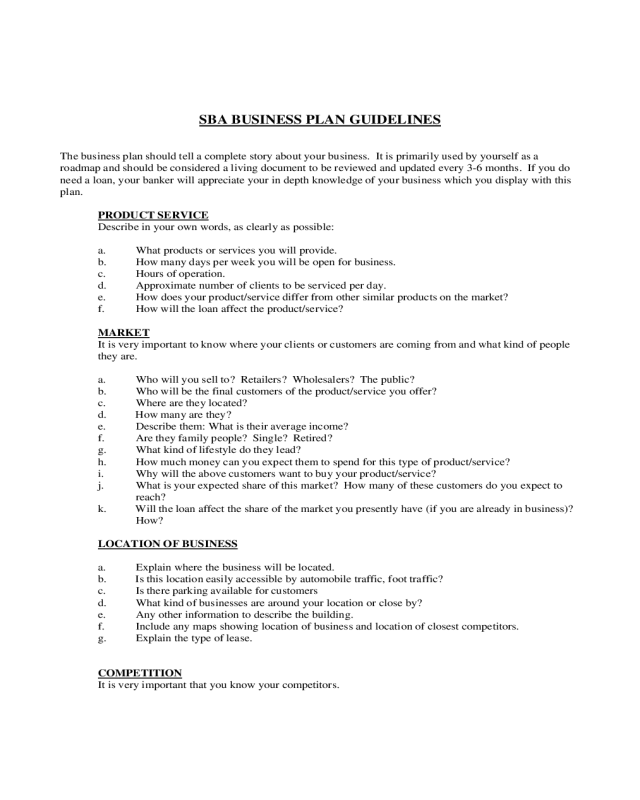Fillable Printable SBA Business Plan Guidelines
Fillable Printable SBA Business Plan Guidelines

SBA Business Plan Guidelines

SBA BUSINESS PLAN GUIDELINES
The business plan should tell a complete story about your business. It is primarily used by yourself as a
roadmap and should be considered a living document to be reviewed and updated every 3-6 months. If you do
need a loan, your banker will appreciate your in depth knowledge of your business which you display with this
plan.
PRODUCT SERVICE
Describe in your own words, as clearly as possible:
a. What products or services you will provide.
b. How many days per week you will be open for business.
c. Hours of operation.
d. Approximate number of clients to be serviced per day.
e. How does your product/service differ from other similar products on the market?
f. How will the loan affect the product/service?
MARKET
It is very important to know where your clients or customers are coming from and what kind of people
they are.
a. Who will you sell to? Retailers? Wholesalers? The public?
b. Who will be the final customers of the product/service you offer?
c. Where are they located?
d. How many are they?
e. Describe them: What is their average income?
f. Are they family people? Single? Retired?
g. What kind of lifestyle do they lead?
h. How much money can you expect them to spend for this type of product/service?
i. Why will the above customers want to buy your product/service?
j. What is your expected share of this market? How many of these customers do you expect to
reach?
k. Will the loan affect the share of the market you presently have (if you are already in business)?
How?
LOCATION OF BUSINESS
a. Explain where the business will be located.
b. Is this location easily accessible by automobile traffic, foot traffic?
c. Is there parking available for customers
d. What kind of businesses are around your location or close by?
e. Any other information to describe the building.
f. Include any maps showing location of business and location of closest competitors.
g. Explain the type of lease.
COMPETITION
It is very important that you know your competitors.

a. Where is your competition located?
b. How far from you?
c. How many competitors are there? List names if possible.
d. How profitable is their business?
e. How are they different from your business?
f. Do you expect to take sales away from these competitors? How?
DISTRIBUTION
It is very important that you know how to reach your customers and what kind of media you will use for
advertising.
a. How will you reach the people you sell to?
b. Would you use sales representatives? Mail orders?
c. How would you let people know about your product/service?
d. Would you advertise? Where?
e. Would you use any other methods? Direct mail, personal contact, flyers, etc.
f. If you have any unique marketing ideas, we would like you to write them down in this category.
SALES
This section has to do with your projected sales.
a. What will be your total monthly and annual sales for the first three years of operation, after you
receive the loan?
b. What will be your cost of sales (cost of merchandise or materials)?
c. What is the basis for your cost of sale figure?
d. What percentage of your sales is the cost of sales?
e. What will your average total expenses per month be?
f. How much money do you need to draw per month for personal expenses?
g. How will the loan affect your sales (if you are already in business)?
h. How much will you have to sell to break even?
i. What could seriously change these sales projections (changes in economy, changes in demand,
etc)?
KEY PERSONNEL
This has to do with people working at your business.
a. Who will be in charge of the business operation?
b. How many employees will you have? Give names of positions or titles.
c. Describe duties and qualifications of each employee, including years of experience in assigned
position.
d. Include personal resume of any employee who will have any administrative responsibilities,
such as manager or assistant manager or any other employee with authority in your business.
e. Include information of (c.) and (d.) about the owner(s).
ORGANIZATION
a. What type of organization are you (corporation, partnership, or sole proprietorship)?
b. If a corporation: Who is on the Board of Directors?
c. If a partnership: Who are the partners? (Give percentage of ownership)
d. Where are the headquarters of the office?
e. Do short term and long term personal goals of the owner(s) harmonize with the business
requirements and objectives?



